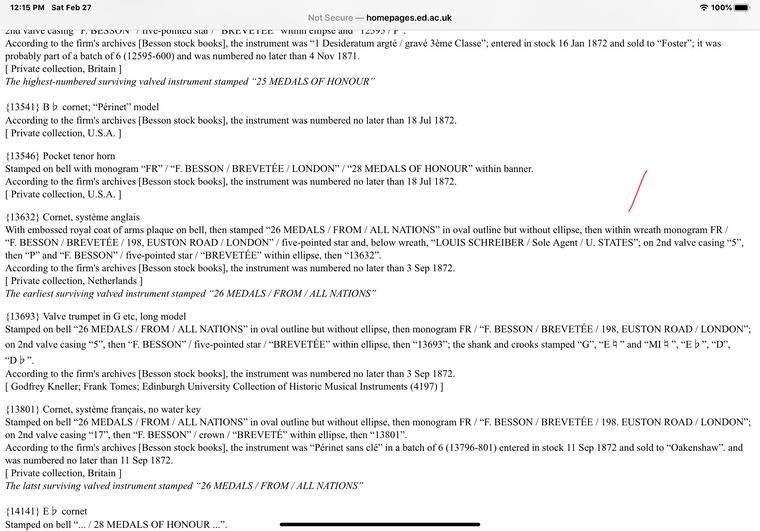1875 Besson Cornet mystery
-
I have a sweet little Besson Brevette Cornet, serial number 13643, silver plated. On the bell is inscribed: F. Besson Brevette; 19 S Euston Road, London; Louis Schrieber , Sole Agent, U. States,
26 medals from all nations.There is a "P" stamped just above the Besson trademark on the middle valve casing. One expert suggested that this "P" means it was actually made in Paris though the bell says London. Maybe the core of the cornet (the three valves connected) was made in Paris and the rest in London? It has slides to convert from Bb to A.
This cornet is very light. I have the feeling that, if I pressed my finger tip against the inside of the bell, I should see the fingerprint on the other outside! It is extremely easy blowing and has a wonderful, dark tone.
The mystery is regarding the three valves. Most trumpets/cornets have the numbers 1, 2. 3 impressed somewhere on the valve itself so it won't get put into the wrong valve casing when reassembling after a cleaning. But this cornet has the numbers: 22, 23, 24. WHY?
-
Check out this site. You may want to contact them for some insight on your cornet and register it on the site so there’s a historical record of it. They registered my 1890 F. Besson and gave me some good info on it. They were pretty slow to respond, though.
http://homepages.ed.ac.uk/am/gdnj.html
Here’s a screen shot of the page containing instruments from that serial number era.

-
Here’s a link to more 19th century Besson history and serial numbers. Your cornet may be a few years older than you think. This is excellent reference material.
-
@dale-proctor Thank you for this information. I was able to reasonably peg the date as 1872 instead of the previously thought 1875.
Matt Ward
-
@matt-ward Re Valve numbering, it was European practice to make valve sets in batches of 33, the valves and casings numbered 1 to 99, although I have seen one trumpet with the valves numbered in the 150s. Regards, Stuart.
-
@matt-ward You might want to post your question on a brass band forum in the U.K. that I joined after TrumpetMaster.com ended.: https://www.themouthpiece.com/ . Since they're closer to the source in terms of location and interest, someone there might have the answer.
UPDATE: I posted this moments after stumac's reply. TheMouthpiece.com is still good for a different perspective on playing.
-
Out of interest I have checked the valve numbering on 4 of my older European trumpets. Selmer Grand Prix sn 53xx 79-80-81, Selmer Balanced sn 153xx 82-83-84, I very much doubt they are from the same batch as the instruments are 10,000 apart. Boosey Cornet 1906 13-14-15. National Musical Supply Co Ltd sn 1 ,193-194-195. Unable to find anything about this company, obviously an European made stencil.ards, Stuart.
-
Thanks to all for these informative replies. I guess the European custom of numbering valves consecutively as they were made explains it, but I don't see the logic they were using unless it was critical that valves 22,23,24 went specifically into valve casings 22,23,24. Do you think they lacked so much uniformity that they wouldn't fit other three valve gangs of the same model? Right now, I'm having a problem with the middle valve sticking. It was working fine until I took the cornet apart for a cleaning. After putting it back together, the middle valve is sluggish and will frequently stick in the down position. I'm taking it to a repairman tomorrow.
-
Yes, they fit the valves to a specific horn, so they stamped them with matching numbers to keep them together during the manufacturing process. They will always start with a 1, or a +3 number - 1,4,7,10,13,16,19,22,...etc. How high they go depended on the number of like instruments in the production run. The next production run would start at 1 again.